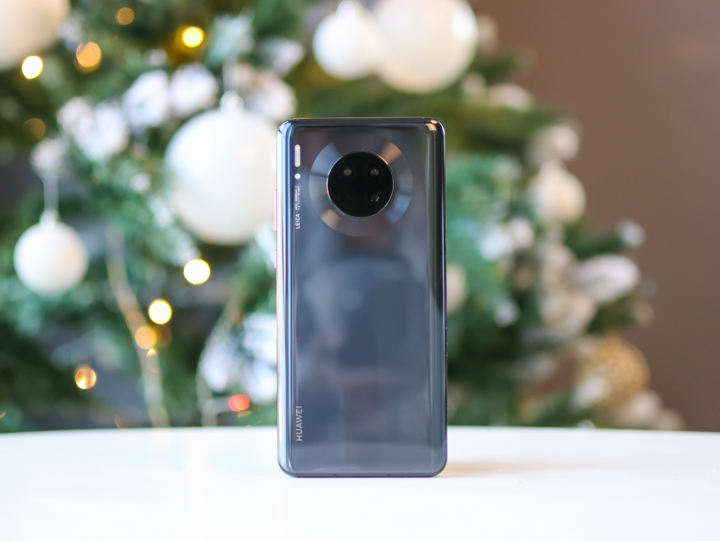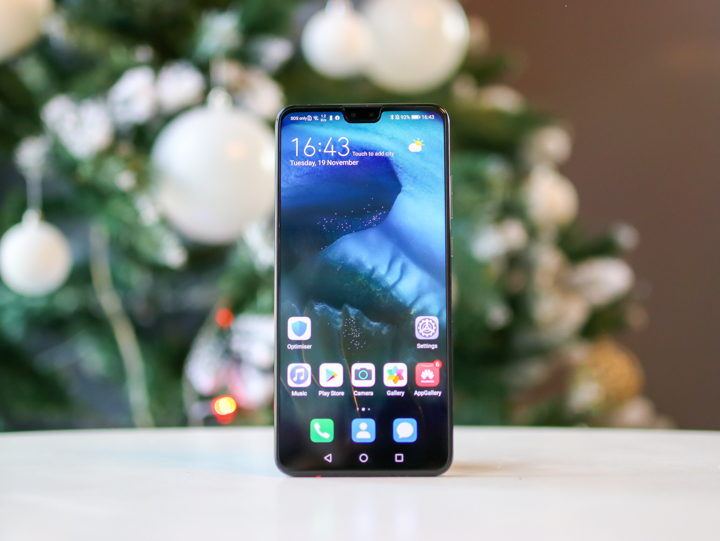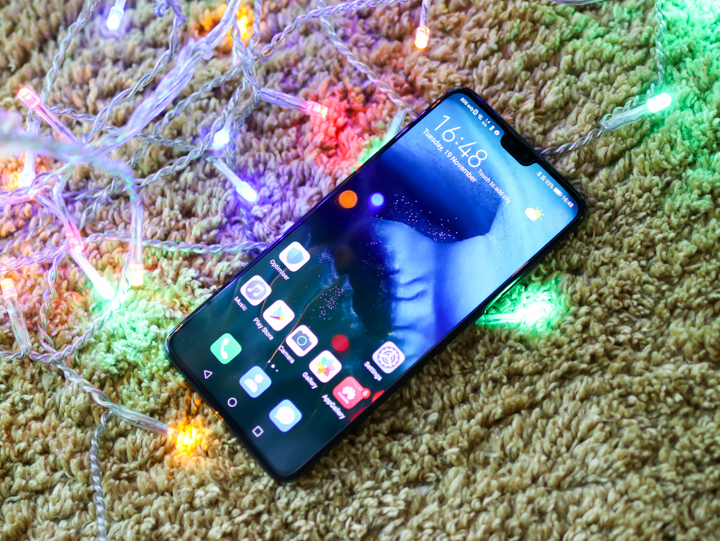2019 has undoubtedly been a wild year for Huawei. Most of the time, it’s good, but sometimes it’s bad. Still, it hasn’t stopped the company from releasing great products like the new Kirin 990 chipset, 5G technology, and smartphones with amazing cameras. One of them is the Mate 30. It’s more affordable than the Mate 30 Pro, still has tons to offer, but also shares the challenges its sibling has. More on that in our review below.
Table of Contents

While the Mate 30 Pro isn’t exactly a mirror of the Mate 20 Pro’s original design, only having some hints, the standard Mate 30 is closer to its predecessor. It’s got that hefty, sturdy feel to it that the Mate 20 Pro famously had. While the Mate 30 Pro is sleek and curvy, this one is no-frills, all business.

The rounded edges and the curvature on the glass back panel are just enough to make your one-handed grip quite comfortable, while the front panel is straight-up flat.

We still get the iconic red-tinted power button on the right side, along with a physical volume rocker. The left side contains the card tray for a single nano-SIM and a Huawei Nano Memory Card.

Up top, we get the secondary microphone and an IR blaster, which is pretty neat.

And down at the bottom, missing from the Pro model, we get a headphone jack. Along with the USB-C port, primary microphone, and loudspeaker.

At the back is the famous circular “washing machine” triple-lens camera module that Huawei says is inspired by Leica’s traditional cameras.

Say what you will, but it’s now an iconic design feature that embodies the look and feel of the Mate series. It does give the phone a bit of a camera bump, but you won’t get much wobble when placed on a table due to its circumference, thickness, and center placement.
Checking out the display, we get a 6.62-inch (slightly larger than the Mate 30 Pro’s 6.53-inch) FHD+ OLED panel with support for HDR10 and the DCI-P3 colorspace. It’s is all fine and dandy since the screen is stunning on its own with sharp details, vivid colors with deep contrast, and excellent outdoor visibility.

Checking out audio, of course, we get a headphone jack that’s missing from the Pro version. For the speakers, it uses a stereo setup comprised of the downward-firing loudspeaker and the earpiece above the display notch.
It does create a stereo effect, but only very slightly. If you were to cover the bottom speaker with your hand, you wouldn’t hear that much sound coming from the earpiece. As a pair, though, it can get loud, mids and highs are clear, and there’s some depth, but only very slightly. As a smartphone speaker, I’d say it’s just average.
So while the P30 Pro is more photo-centric and the Mate 30 Pro is more video-centric, the Mate 30 and well, the P30 for that matter is more vanilla in their camera capabilities. It means that we don’t get super fancy features like 50x zoom or 7680FPS super slow-mo video, but we still do get proper hardware.

For the rear, that’s a 40MP main, 16MP ultrawide, and an 8MP telephoto with 3x optical zoom. On the front is a 24MP selfie shooter along with a TOF camera for Face Unlock. Without a doubt, all three rear cameras take great photos.
The AI scene detection works very fast, thanks to a sizable database of known subjects, which is very helpful since the post-processing can better apply the appropriate exposure and saturation settings. Shots are sharpened quite a bit with boosted contrast and colors. However, it manages to make your subjects look pleasing despite not being precisely natural-looking or true-to-life.
The primary camera’s shots are particularly sharp, thanks to the high-resolution sensor. Even when shooting with the ultrawide and telephoto cameras, the look of the photos is very consistent. The ultrawide lens provides an awesomely huge field-of-view without too much distortion, and the telephoto lens gets up to 3x optical zoom, 5x hybrid zoom, and 30x digital zoom. Quality naturally scales down the farther you zoom in, but the software does kick in and try its best to sharpen the shot.
For selfies, the device handles them quite well. Colored objects in-frame get a bit of a saturation boost, but skin tones are well-preserved and natural-looking. The same goes for the rear cameras when you take photos of other people.
Speaking of that, checking out portrait mode, it does a great job with subject-background separation, as well as providing an accurate bokeh effect. It doesn’t just blindly blur out whatever’s behind the subject but takes distance into account as a deciding factor for blur intensity.
As for low light, which we know is an area where Huawei cameras shine, we get the quality we expected. Even without Night Mode, shots don’t come out too noisy, while details and colors are still, for the most part, preserved. And all of this is expected — after all, Huawei is one of the industry leaders when it comes to low light photography.
For videos, we can shoot up to 4K at 60FPS for the rear, and up to 1080p at 30FPS for the front. Video quality almost closely matches what we get from photos, with similar sharpening and saturation boost. Stabilization is also excellent and has built-in filters that are fun to use.

The Mate 30 runs on EMUI 10 based on Android 10. The look and feel of the UI are pretty much similar to EMUI 9, but with some visual tweaks. So yes — Google Mobile Services are not pre-installed. To recap, these are apps and services provided by Google under license with any Android-based OS.
With our Mate 30 Pro from before, we were able to sideload the Google Play Store using the LZPlay method. But right now, that method no longer works. We were still able to get the Play Store though using a PC program called HiSuite to restore specific system settings that allow us to use LZPlay once again.
So yeah — on our Mate 30, we were able to get the Google Play Store. Social Media apps work, Mobile Legends, Call of Duty work. So far, only Netflix was not supported. You still get access to other video platforms like YouTube, though.

Which brings me to something I’ve been saying ever since the Trade Ban came along — are users willing to accept methods like this as a band-aid solution with no certainty of support for your favorite apps? Right now, the Netflix app isn’t working. What if tomorrow, Facebook is no longer supported? Or Gmail? Or Google itself?
Sure, it’s not so much of an inconvenience to side-load Google Play Services. Still, in the grand scheme of things, you’re taking a significant risk if you decide to get a Huawei phone as your daily driver nowadays because of the uncertainty.
That is, of course, if you’re banking on Google. Huawei does have its own App Gallery that has some commonly used apps. Then again, this is also dependent on other factors such as Huawei’s ability to garner support from developers. It’s a perfect example of how Google’s services, a feature that most people take for granted, can affect an excellent Android phone’s marketability.
For the internals, the Mate 30 is powered by the Kirin 990 7nm chipset with a Mali-G76 MP16 GPU along with 8GB of RAM and 128GB of UFS 3.0 storage. This phone is a beast at raw performance. It’s swift and snappy and can take on a lot of heavy apps without breaking a sweat. The Mali G76 is a 16-core GPU, so heavy graphics workloads like playing games such as COD and Mobile Legends is no issue at all.
Our benchmark scores over here back that up if you guys are interested in specific numbers:

• AnTuTu v8 – 375,209
• 3D Mark SSE – 5,662 (OpenGL ES 3.1), 3,014 (Vulkan)
• PC Mark – 8,647 (Work 2.0)
• Geekbench – 752 (Single-Core), 2,761 (Multi-Core), 3,705 (OpenCL)
• AndroBench – 1,467.7 MB/s (Seq. Read), 231.69 MB/s (Seq. Write)
Providing power is a 4,200mAh battery with support for 40W SuperCharge and 27W Fast Wireless Charging. It’s got a slightly smaller capacity than the Mate 30 Pro, but that’s okay since battery life is still great.

In our standard video loop test, we got 21 hours and 34 minutes of playback. In day-to-day use, it’s possible to stretch battery life to two days if you use the device moderately.
But even if you did need to charge, it’s no problem at all as long as you have access to a SuperCharge charger. It’s just so fast. We tested Huawei’s claim of 70% in 30 minutes, and it exceeded this for us, reaching 73% in the same amount of time.
Based on all of this, there are plenty of reasons to get the Mate 30, one of them is photography. But are the cameras enough of a redeeming factor that it trumps the lack of official Google Services?

For some people, it may be the case. But that’s not the only positive factor the Mate 30 has, of course — It’s got a good display, excellent performance, long battery life, and a reasonable price of PHP34,990USD 596INR 50,547EUR 568CNY 4,342. That’s a whole 16,000 pesos cheaper than the Mate 30 Pro. And for that much less, it’s still a well-rounded, well-executed smartphone.
In a nutshell, I can recommend the Mate 30, but only to those who are willing to take the risk. If you’re not that type of person, though, then you’ll want to think hard on whether or not the phone’s good qualities will fill the hole in the smartphone experience left by the lack of Google’s official services.
What we liked:
What we didn’t:

YugaTech.com is the largest and longest-running technology site in the Philippines. Originally established in October 2002, the site was transformed into a full-fledged technology platform in 2005.
How to transfer, withdraw money from PayPal to GCash
Prices of Starlink satellite in the Philippines
Install Google GBox to Huawei smartphones
Pag-IBIG MP2 online application
How to check PhilHealth contributions online
How to find your SIM card serial number
Globe, PLDT, Converge, Sky: Unli fiber internet plans compared
10 biggest games in the Google Play Store
LTO periodic medical exam for 10-year licenses
Netflix codes to unlock hidden TV shows, movies
Apple, Asus, Cherry Mobile, Huawei, LG, Nokia, Oppo, Samsung, Sony, Vivo, Xiaomi, Lenovo, Infinix Mobile, Pocophone, Honor, iPhone, OnePlus, Tecno, Realme, HTC, Gionee, Kata, IQ00, Redmi, Razer, CloudFone, Motorola, Panasonic, TCL, Wiko
Best Android smartphones between PHP 20,000 - 25,000
Smartphones under PHP 10,000 in the Philippines
Smartphones under PHP 12K Philippines
Best smartphones for kids under PHP 7,000
Smartphones under PHP 15,000 in the Philippines
Best Android smartphones between PHP 15,000 - 20,000
Smartphones under PHP 20,000 in the Philippines
Most affordable 5G phones in the Philippines under PHP 20K
5G smartphones in the Philippines under PHP 16K
Smartphone pricelist Philippines 2024
Smartphone pricelist Philippines 2023
Smartphone pricelist Philippines 2022
Smartphone pricelist Philippines 2021
Smartphone pricelist Philippines 2020
Paul says:
I like how it kept the FM radio like the Mate 20 before it, in other flagship they don’t have that feature. It’s really useful when you’re traveling and you don’t want to burn through all your data just to listen to music.
Glen L says:
besides NetFlix, I’ve read online that LINE and Google Pay doesn’t work as well. Can you guys confirm this?